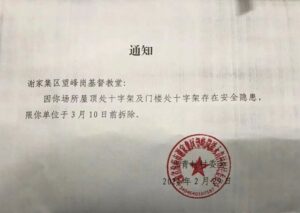(Huainan, Anhui Province – March 15, 2024) Another case of cross-removal has emerged in China. Recently, the Wangfenggang Christian Church in Xiejiaji District, Huainan City, Anhui Province, received a notice to remove crosses.
The church received a written notice from the Villagers’ Committee of Yongqing Village in Wangfenggang Town, Xiejiaji District, Huainan City, Anhui Province. The village-level management committee, controlled by the Chinese government, ordered the Wangfenggang Christian Church to remove two crosses on the roof and at the entrance of the church by March 10. The authorities could not produce an official legal basis for the notice but cited potential “safety” hazards.
According to Chinese law, a villagers’ committee “ is the primary mass organization of self-government, in which the villagers manage their own affairs,” it is not an administrative agency and does not have administrative law enforcement qualifications. The issuance of the notice has no legal effect.
The Yongqing Villagers’ Committee did not provide a safety assessment report from qualified personnel of relevant departments. If there were genuine safety concerns regarding the crosses in the church, the assessment should have been commissioned by the church and conducted by authorized parties. The villager’s committee is not qualified to conduct safety assessments, as they lack the necessary equipment and are therefore unable to issue qualified assessment reports.
It was revealed that the cross on the church’s roof was constructed according to construction drawings, and after completion, it underwent testing and inspection by relevant departments. It has been in use for five years since passing the inspection. The cross at the church’s entrance has been in use for over forty years without any safety issues. For a villagers’ committee to arbitrarily conclude that “there are potential safety hazards with the crosses on the roof and at the entrance” without any basis is typical bureaucracy.
Such written notices requesting the removal of crosses are usually issued by religious departments, but this time it was issued by the villagers’ committee, clearly avoiding the involvement of the religious department, and not being held accountable. Issuing written notices to remove crosses involves sensitive religious issues. While China restricts the development of religion and suppresses religious groups or individuals, it also does not want to be criticized internationally for religious persecution. The departments issuing such notices are often under political pressure from higher government authorities.
Over the past thirty years, crosses have been allowed to be used as symbols of Christian churches or meeting places in both urban and rural China. Even to some extent, unregistered church groups of Christianity and Catholicism were tacitly accepted. However, starting in 2014, the situation of religious tolerance began to reverse comprehensively. The Chinese government first began to remove crosses from churches in Yuyao City, Zhejiang Province; a province with a high population of Christians. In the following three years, over a thousand crosses were removed from Zhejiang Province. The cross-removal campaign later extended to provinces such as Henan, Anhui, and Jiangxi and also affected regions such as Shandong and Xinjiang.

